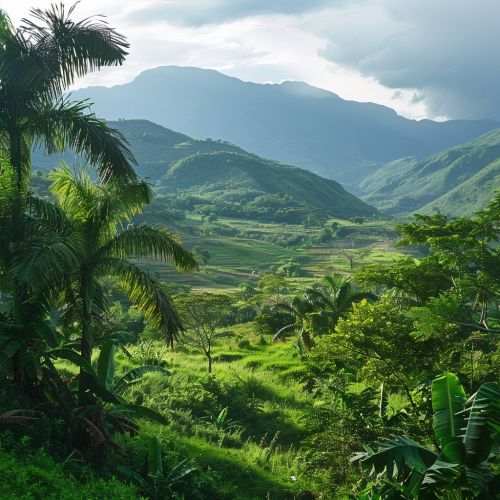Haiti
Geography
Haiti, officially known as the Republic of Haiti, is located on the island of Hispaniola in the Greater Antilles archipelago of the Caribbean Sea. It occupies the western three-eighths of the island, which it shares with the Dominican Republic. Haiti is 27,750 square kilometers (10,714 sq mi) in size and the third largest country in the Caribbean by area.


The country's geography is marked by mountains interspersed with small coastal plains and river valleys. The climate is tropical with some variation depending on altitude. The highest point in Haiti is Pic la Selle, at 2,680 meters (8,793 ft).
History
Haiti's history is characterized by remarkable resilience and cultural identity. The indigenous Taíno people, who inhabited the island of Hispaniola before the arrival of Europeans, named it Ayiti ("Land of High Mountains"), which was later Hispanized as Haiti.
In 1492, Christopher Columbus landed on the island and claimed it for the Spanish Crown. The Spanish exploited the island for its gold, decimating the Taíno population. In the early 17th century, the French established a presence on Hispaniola, and in 1697, Spain ceded the western third of the island to France. The French colony, based on forestry and sugar-related industries, became one of the wealthiest in the Caribbean but only through the heavy importation of African slaves and considerable environmental degradation.
In the late 18th century, Haiti's nearly half a million slaves revolted under the leadership of Toussaint Louverture. After a protracted struggle, Haiti became the first post-colonial independent black-led nation in the world, and the only nation whose independence was gained as part of a successful slave rebellion.
Politics
Haiti is a semi-presidential republic with a multi-party system. The Constitution of Haiti establishes the structure of the Haitian government and sets out the rights and duties of its citizens. The President of Haiti is the head of state, while the Prime Minister is the head of government.
The political history of Haiti is marked by numerous coups d'état, with the country's politics characterized by a long history of political instability and corruption. Despite these challenges, Haiti has made significant progress in improving governance and tackling corruption in recent years.
Economy
Haiti's economy is predominantly informal and relies heavily on small-scale subsistence farming. Agriculture, together with forestry and fishing, accounts for about one-fourth of GDP and employs about two-thirds of the labor force. The country's largest source of foreign income comes from remittances by Haitians living abroad, particularly in the United States.
Haiti is the poorest country in the Americas and one of the poorest in the world, with poverty, corruption, poor infrastructure, lack of health care and lack of education cited as the main sources. The economy has been recovering slowly from the devastation caused by the 2010 earthquake and the damage caused by several hurricanes.
Culture
Haiti has a rich and unique cultural history, having been inhabited by indigenous Taíno peoples, Spanish and French colonizers, and African slaves. Its culture is a mix of African, French, and indigenous Taíno influences, with a strong influence from the Roman Catholic Church.
Haitian culture is well known for its strong connection to music, dance, and art, particularly the vibrant and iconic genre of Vodou drumming and the internationally recognized naive art tradition. The official languages of Haiti are French and Haitian Creole, the latter a French-based creole language heavily influenced by West African languages.
